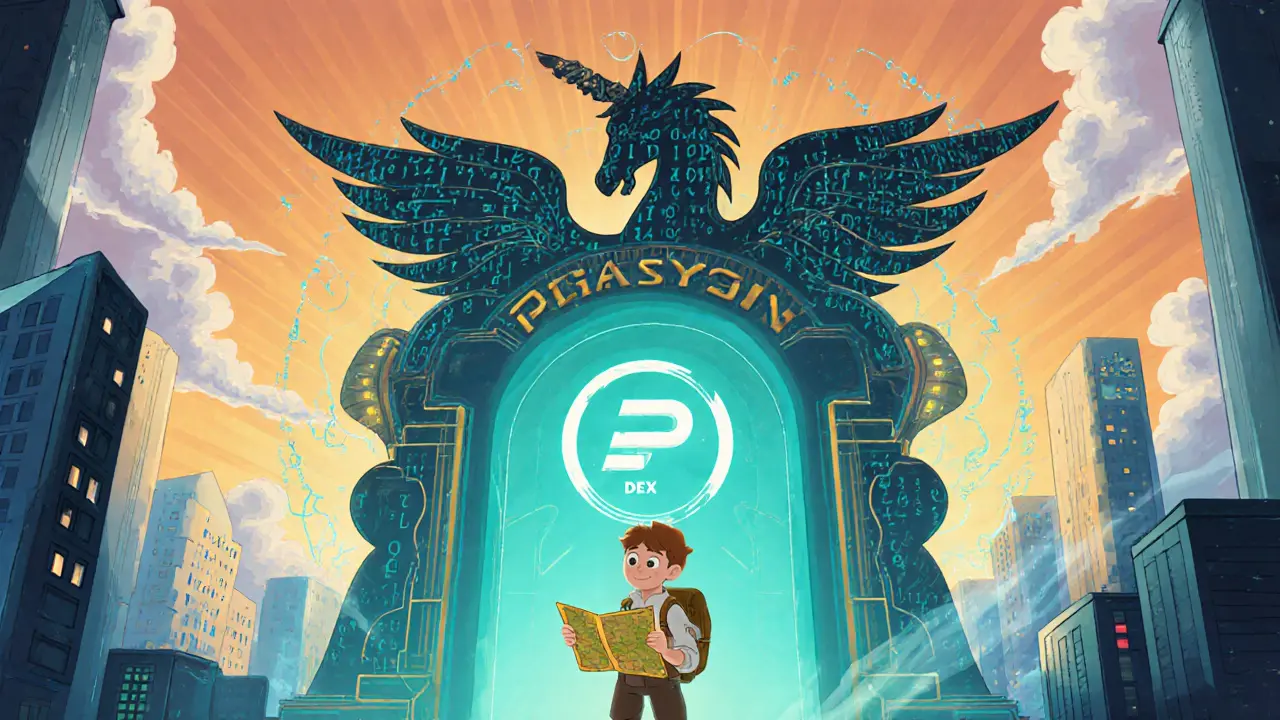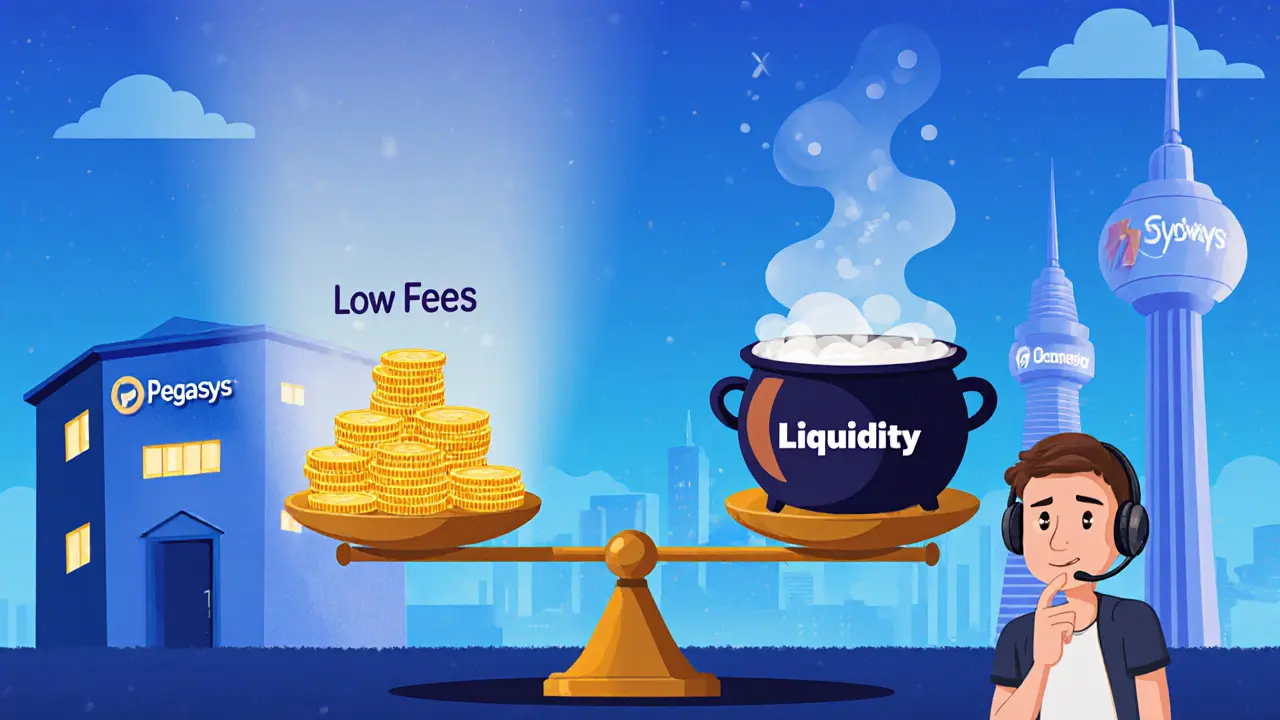 Jun, 27 2025
Jun, 27 2025
Pegasys DEX Fee Calculator
Calculate Your Trade Costs
Compare trading fees between Pegasys (Syscoin) and other major decentralized exchanges for your trade amount.
Trading Cost Comparison
| Platform | Gas Cost | Swap Fee (0.25-0.30%) | Total Cost | Savings vs. Ethereum |
|---|---|---|---|---|
| Pegasys (Syscoin) | $0.003 | $0.25 | $0.253 | $0.000 |
| Uniswap (Ethereum) | $2.50 | $0.30 | $2.80 | $2.547 |
| PancakeSwap (BNB Chain) | $0.05 | $0.25 | $0.30 | $0.047 |
Small trade tip: For trades under $100, Pegasys typically saves you over 90% in fees compared to Ethereum-based DEXs.
If you’ve been hunting for a niche decentralized exchange that lives on a blockchain other than Ethereum or BNB, chances are you’ve stumbled on Pegasys exchange review headlines. Pegasys bills itself as a non‑custodial DEX built on the Syscoin network, promising low‑cost swaps and permission‑less trading for the Syscoin community. But does it live up to the hype, or is it another footnote in the crowded DeFi landscape? This deep dive breaks down the protocol, fees, security, liquidity, and who might actually benefit from using Pegasys.
What is Pegasys?
Pegasys is a decentralized exchange protocol that runs on the Syscoin blockchain, allowing users to swap digital assets without handing over private keys to a third party. Launched by Pegasys Labs, the platform is accessed through a web UI at pegasys.fi. Unlike centralized exchanges such as Binance or Coinbase, Pegasys never stores your funds; every trade happens on‑chain through smart contracts.
How the Syscoin‑Based DEX Works
At its core, Pegasys follows the automated market maker (AMM) model popularized by Uniswap. Liquidity providers deposit pairs of tokens into a pool, and traders swap against that pool at prices determined by a constant‑product formula. Because the protocol lives on Syscoin, the settlement uses Syscoin’s consensus rather than Ethereum’s EVM, resulting in significantly cheaper transaction fees.
- Connect a wallet: You need a Web3‑compatible wallet like MetaMask, Trust Wallet, or the Syscoin‑specific Nifty Wallet.
- Select a pool: Choose a token pair (e.g., SYS/USDT) that has enough liquidity.
- Enter the amount: The UI shows the estimated output based on current pool depth and slippage settings.
- Confirm on‑chain: Your wallet signs the transaction, and the swap is executed instantly on the Syscoin network.
The entire flow mirrors other DEXs, so anyone familiar with Uniswap or PancakeSwap will feel at home, with the only real difference being the underlying blockchain.
Fees, Gas Costs, and Trading Expenses
Pegasys follows the typical AMM fee structure: a small percentage of each swap goes back to liquidity providers, and a protocol fee may be taken by the Pegasys team. Public documentation does not lock down an exact rate, but based on patterns across similar DeFi platforms the fee sits around 0.25%-0.30% per trade.
Where Pegasys shines is the gas cost. Syscoin’s transaction fees hover in the $0.001-$0.005 range, dramatically lower than Ethereum’s $1-$5 spikes during network congestion (Etherscan data, 2023). For traders moving small amounts, this fee difference can be the deciding factor.
There are no hidden KYC fees or withdrawal charges because you never withdraw to a custodial account; you simply move tokens out of your wallet to another address.
Security and Audit Landscape
Security is the elephant in the room for any DeFi platform, and Pegasys unfortunately offers limited public reassurance. The Terms of Service (last updated July242023) confirm the protocol is non‑custodial, but there is no linked audit report from firms like TrailofBits or OpenZeppelin.
In contrast, major DEXs publish audit certificates that detail smart‑contract vulnerabilities, code coverage, and remediation steps. The absence of such documentation for Pegasys means users must rely on community trust and the reputation of Syscoin’s core development team.
One mitigation strategy is to start with small swaps, monitor the pool’s health, and keep an eye on any security advisories posted on the official Discord (if it exists). If you’re a risk‑averse investor, you might prefer a DEX with a transparent audit trail.

Liquidity, TVL, and Trading Volume
Liquidity is the lifeblood of any AMM. Pegasys currently focuses on Syscoin‑native assets, so the total value locked (TVL) is modest. Public DeFi aggregators like DeFiLlama do not list Pegasys, suggesting TVL is well below $10million-tiny compared with Uniswap’s $3.9billion or Curve’s $1.3billion as of late2023.
Trading volume data is similarly scarce. While Uniswap logged $319.4billion in 2022, Pegasys lacks a public dashboard, making it hard to gauge activity. Low volume can mean higher slippage for larger trades, so users dealing with substantial sums should verify pool depth before committing.
Comparison with Major DEXs
| Feature | Pegasys (Syscoin) | Uniswap (Ethereum) | PancakeSwap (BNB Chain) |
|---|---|---|---|
| Blockchain | Syscoin | Ethereum | BNB Chain |
| Typical Gas Cost | $0.001‑$0.005 | $1‑$5 (peak) | $0.02‑$0.10 |
| Swap Fee | ~0.25‑0.30% | 0.30% | 0.25‑0.30% |
| TVL (approx.) | <$10M | $3.9B | $2.2B |
| Cross‑Chain Support | No | Yes (via bridges) | Yes |
| Public Security Audits | None disclosed | Multiple audits | Multiple audits |
The table makes it clear: Pegasys is a niche player with ultra‑low fees but limited liquidity and little public scrutiny. If you’re already deep in the Syscoin ecosystem, those trade‑offoffs might be acceptable.
Pros and Cons
- Pros
- Very low transaction fees thanks to Syscoin.
- Non‑custodial - you control your private keys.
- Straightforward web UI; no need for KYC.
- Cons
- Thin liquidity and low TVL can cause slippage.
- No public security audit, raising safety concerns.
- Lack of cross‑chain bridges limits token variety.
- Community presence and support channels appear minimal.

Who Should Consider Pegasys?
If you’re a Syscoin holder looking to swap SYS‑based tokens without paying Ethereum‑level gas, Pegasys is worth a try. It’s also suitable for developers building on Syscoin who want an on‑chain swap primitive. However, if you trade large volumes, need a wide array of assets, or require audited security, mainstream DEXs like Uniswap or PancakeSwap remain safer bets.
Step‑by‑Step: Getting Started on Pegasys
- Install a Web3 wallet: MetaMask is the most common choice. Make sure it’s set to the Syscoin network (add the RPC URL from Syscoin docs if needed).
- Fund your wallet: Transfer SYS or any other Syscoin‑compatible token to the address.
- Use an exchange that lists SYS (e.g., KuCoin) to buy and withdraw.
- Open Pegasys UI: Go to pegasys.fi and click “Connect Wallet”.
- Select a pool: Browse the list of available liquidity pools. Click on the pair you want to trade.
- Enter trade details: Set the amount you want to sell, adjust slippage tolerance (usually 0.5% is safe), and review the estimated output.
- Confirm transaction: Your wallet will pop up asking you to sign. Review gas cost (usually a few cents) and approve.
- Check the receipt: The UI shows a confirmation with transaction hash. You can view it on a Syscoin block explorer.
That’s it. Because the protocol is non‑custodial, the tokens land directly in your wallet once the transaction is final.
Future Outlook and Development Momentum
The last public update from Pegasys Labs was the Terms of Service revision in July2023. Since then, there have been no major blog posts, roadmap releases, or social‑media bursts. Compared with Uniswap’s V4 rollout in Q32023, Pegasys appears stagnant. However, Syscoin itself is making strides: a recent upgrade lowered block times and improved scalability, which could indirectly benefit Pegasys by making swaps even cheaper. If the community pushes for cross‑chain bridges or audits, the platform could gain traction. For now, consider Pegasys a “watch‑and‑wait” project: useful for specific Syscoin‑centric needs but not a primary gateway to the wider DeFi world.
Frequently Asked Questions
Is Pegasys safe to use without a security audit?
Safety depends on how much you trade. For tiny amounts, the risk is low, but without a public audit you can’t verify the smart‑contract code. It’s best to start with small swaps and keep an eye on community alerts.
What wallets are compatible with Pegasys?
Any Web3‑enabled wallet that can connect to the Syscoin network works - MetaMask, Trust Wallet, and the native Nifty Wallet are the most common choices.
How do Pegasys fees compare to Ethereum DEXs?
Pegasys charges about 0.25‑0.30% per swap, similar to other AMMs, but the underlying gas is a few thousandths of a dollar - dramatically cheaper than Ethereum’s $1‑$5 typical fees.
Can I provide liquidity on Pegasys?
Yes. By depositing equal values of two tokens into a pool you earn a share of the swap fees. Because TVL is low, returns can be higher but also more volatile.
Is there any KYC requirement?
No. Pegasys is fully non‑custodial, so you never create an account or submit identity documents.
Bobby Lind
June 27, 2025 AT 10:56Wow, Pegasys really shines with those ultra‑low fees, it's like a breath of fresh air for small‑scale traders, and the fact that it's built on Syscoin means you dodge those crazy Ethereum gas spikes, which is a massive win, especially when you're swapping just a few bucks!
DeAnna Brown
July 2, 2025 AT 02:10Listen up, fellow Americans! This Syscoin‑based DEX is a bold step forward, proving that innovation doesn't have to be confined to the big chains, and I’m thrilled to see home‑grown talent pushing the boundaries, because nothing beats the pride of seeing a home‑grown solution compete on a global stage!
Chris Morano
July 6, 2025 AT 17:24Pegasys offers lower transaction costs compared to Ethereum, which may benefit users seeking affordable swaps.
Ikenna Okonkwo
July 11, 2025 AT 08:38When you consider the underlying architecture, Pegasys presents an intriguing case study in how alternative blockchains can challenge the status quo, and while the TVL may be modest, the potential for niche liquidity pools invites a thoughtful discussion about market dynamics.
Laura Hoch
July 15, 2025 AT 23:52Honestly, the sheer audacity of Pegasys to claim “non‑custodial” without a solid audit is a slap in the face to seasoned DeFi devotees, and the fluffy marketing gloss hides a cavernous void where real security should reside, making me question the integrity of the whole venture.
Devi Jaga
July 20, 2025 AT 15:06Oh great, another AMM on a side‑chain, because the DeFi ecosystem clearly needs more “innovative” protocols that copy Uniswap’s formula verbatim while pretending to be revolutionary – just another layer of liquidity fragmentation, no?
Hailey M.
July 25, 2025 AT 06:20Wow, Pegasys looks like the “next big thing” on paper, but let’s be real – tiny TVL, no audit, and you’re basically swapping in a vacuum – 😂🤦♀️
Schuyler Whetstone
July 29, 2025 AT 21:34People need to stop ignoring the red flags – no audit, low liquidity, and it’s definetly not a safe place for your hard earned crypto, dont be fooled by slick UI.
David Moss
August 3, 2025 AT 12:48Some say Pegasys is just another front for hidden hands pulling strings, and if you look closely you’ll notice the silence around audits, the vague roadmaps, and the way the community is strangely quiet – could be by design.
Kaitlyn Zimmerman
August 8, 2025 AT 04:02If you’re new to Syscoin‑based swapping, start with a tiny amount, check the pool depth on the explorer, and use a reputable wallet like MetaMask to avoid any unexpected hiccups.
Jessica Cadis
August 12, 2025 AT 19:16Pegasys is overhyped and underdelivered – plain and simple.
Katharine Sipio
August 17, 2025 AT 10:30It is commendable that Pegasys seeks to reduce transaction fees; however, prospective users should remain vigilant regarding the platform’s liquidity and audit status.
Cecilia Cecilia
August 22, 2025 AT 01:44Low fees are appealing yet security remains uncertain.
lida norman
August 26, 2025 AT 16:58Imagine swapping with almost no gas costs, feeling the thrill of a truly decentralized trade – 🌟🚀
Miguel Terán
August 31, 2025 AT 08:12Pegasys represents a fascinating experiment in taking decentralized exchange functionality off the crowded Ethereum highway.
By anchoring itself to the Syscoin network it inherits a blockchain that has been quietly optimized for fast and cheap transactions for several years.
The AMM model it employs is essentially a replica of the classic constant product formula, which means users familiar with Uniswap will not need to relearn the mechanics.
Yet the low gas fees open up possibilities for micro‑traders who previously found themselves priced out of the market.
The platform’s user interface, accessed through pegasy.fi, strikes a balance between simplicity and the inclusion of advanced settings such as slippage tolerance and deadline controls.
Liquidity pools, while modest in size, are nonetheless functional for common pairs like SYS/USDT and allow early adopters to earn modest fees as providers.
One of the notable advantages is the ability to retain full control of private keys, ensuring that no custodial entity can freeze or seize assets.
However, the absence of a publicly available security audit raises legitimate concerns that cannot be ignored.
Community members have pointed out that the lack of comprehensive documentation makes it harder for newcomers to assess risk.
In practice, this means that any large swap carries the risk of slippage that could erode expected returns.
Nevertheless, for those willing to trade smaller amounts the fee savings can be substantial over time.
The project’s roadmap hints at cross‑chain bridges that could eventually bring assets from other ecosystems into the Syscoin sphere.
If these bridges materialize, Pegasys could see a surge in both liquidity and user adoption.
Until then, cautious experimentation remains the prudent path for anyone considering the platform.
Overall, Pegasys offers a compelling blend of low‑cost trading and decentralized ethos, but it must earn trust through transparent security practices before it can be deemed a mainstream contender.
Shivani Chauhan
September 4, 2025 AT 10:56While your overview captures the key points, I would add that the economic viability of such low‑fee pools hinges on sustained liquidity incentives, which currently appear limited.